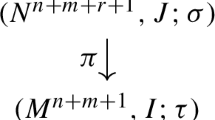Abstract
Generalized linear systems are classified according to their algebraic structure and their regularizability and normalizability properties under generalized state feedback are investigated. New feedback invariants are introduced in terms of the input-space restriction pencil and the Plücker matrix of the system. It is shown that the classification of subspaces of the state space of generalized linear systems is reduced to an equivalent problem of classifying the subspacesV of the domain of an ordered pair (F, G), F, Gεℝm×n. The set of strict equivalence invariants of the restriction pencil (F, G)/V provides a complete, basis-free algebraic characterization and leads to the definition of notions of geometric invariance. The key geometric notions that emerge are those of (F, G)-, (G, F)-, complete-(F, G)-, partitioned(F, G)-, cyclic-, and semicyclic-invariant subspaces. A complete set of geometric algorithms leading to the computation of the above families is also given. The above families of invariant subspaces are characterized in terms of the invariants of (F, G)/V, and this provides the links with their dynamic characterization. These results provide an “open-loop” or “feedback-free” unifying treatment of spaces of generalized systems, which for the case of proper systems is reduced to the standard geometric theory results.
Similar content being viewed by others
References
D. J. Aplevich, Minimal representations of implicit linear systems,Automatica,21 (1985), 259–269.
P. Bernhard, On singular implicit linear dynamical systems,SIAM J. Control Optim.,20 (1982) 612–633.
J. D. Cobb, Fundamental properties of the manifold of singular and regular systems,J. Math. Anal. Appl.,120 (1986), 328–353.
G. D. Forney, Minimal bases of rational vector spaces with applications to multivariable linear systems,SIAM J. Control Optim.,13 (1975), 493–520.
F. R. Gantmacher,Theory of Matrices, Vol. 2, Chelsea, New York (1959).
C. Giannakopoulos and N. Karcanias, Pole assignment of strictly proper and proper systems by constant output feedback,Internat. J. Control,42 (1985), 543–565.
S. Jaffe and N. Karcanias, Matrix pencil characterization of almost (A, B)-invariant subspaces: A classification of geometric concepts,Internat. J. Control,33 (1981), 51–93.
G. Kalogeropoulos, Matrix Pencils and Linear Systems Theory, Ph.D. Thesis, Control Engineering Centre, The City University, London (1985).
N. Karcanias, Matrix pencil approach to geometric system theory,Proc. IEE,126 (1979), 585–590.
N. Karcanias, Regular state-space realizations of singular system control problems,Proc. 26th IEEE CDC, Los Angeles, Dec. 9–11, 1987, Vol. 2, pp. 1144–1146.
N. Karcanias and C. Giannakopoulos, Grassmann invariants, almost zeros and the determinantal zero, pole assignment problems of linear systems,Internat. J. Control,40 (1984), 673–698.
N. Karcanias and G. E. Hayton, Generalized autonomous dynamical systems, algebraic duality and geometric theory,Proc. IFAC VIII Triennial World Congress, Kyoto, 1981.
N. Karcanias and G. Kalogeropoulos, Bilinear strict equivalence of matrix pencils, inProc. 4th IMA Conference on Control Theory, (P. A. Cook, ed.), Academic Press, New York (1985), pp. 77–86.
N. Karcanias and G. Kalogeropoulos, A matrix pencil approach to the study of singular systems: Algebraic and geometric aspects,Proc. Internat. Symp. on Singular Systems, Atlanta, Dec. 1987.
N. Karcanias, B. Laios, and C. Giannakopoulos, The decentralized determinantal assignment problem: Fixed and almost fixed modes and zeros,Internat. J. Control,48 (1988), 129–147.
F. L. Lewis, A survey of linear singular systems,Circuits Systems Signal Process.,5 (1986), 3–36.
J. J. Loiseau, Some geometric considerations about the Kronecker normal form,Internat. J. Control,42 (1985), 1411–1431.
D. G. Luenberger, Time-invariant descriptor systems,Automatica,14 (1978), 473–480.
M. Malabre, More geometry about singular systems,Proc. 26th IEEE CDC, Los Angeles, Dec. 9–11, 1987.
M. Marcus,Finite Dimensional Multilinear Algebra (in two parts), Marcel Dekker, New York (1973).
M. Marcus and H. Minc,A Survey of Matrix Theory and Matrix Inequalities, Allyn and Bacon, Boston (1964).
K. Ozcaldiran, Control of Descriptor Systems, Ph.D. Thesis, School of Electrical Engineering, Georgia Institute of Technology, Atlanta (1985).
H. H. Rosenbrock, Structural properties of linear dynamical systems,Internat. J. Control,20 (1974) 191–202.
M. A. Shayman and Z. Zhou, Feedback control and classification of generalized linear systems, Preprint (1986).
H. W. Turnbull and A. C. Aitken,An Introduction to the Theory of Canonical Matrices, Dover, New York (1961).
G. C. Verghese, Infinite-Frequency Behavior in Generalized Dynamical Systems, Ph.D. Thesis, Department of Electrical Engineering, Stanford University (1978).
M. E. Warren and A. E. Eckberg, On the dimensions of controllability subspaces: A characterization via polynomial matrices and Kronecker invariants,SIAM J. Control Optim.,13 (1975), 434–445.
J. H. Wilkinson, Linear differential equations and Kronecker's canonical form, inRecent Advances in Numerical Analysis (C. de Boor and G. Golumb, eds.), Academic Press, New York (1978).
J. C. Willems, Almost invariant subspaces. An approach to high gain feedback design, Parts I and II,IEEE Trans. Automat. Control,26 (1981), 235–252;27 (1982) 1071–1085.
W. M. Wonham,Linear Multivariable Control: A Geometric Approach, 2nd edn., Springer-Verlag, New York (1979).
Author information
Authors and Affiliations
Rights and permissions
About this article
Cite this article
Karcanias, N., Kalogeropoulos, G. Geometric theory and feedback invariants of generalized linear systems: A matrix pencil approach. Circuits Systems and Signal Process 8, 375–397 (1989). https://doi.org/10.1007/BF01598421
Received:
Revised:
Issue Date:
DOI: https://doi.org/10.1007/BF01598421



